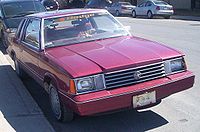- Dodge Aries
-
Dodge Aries 
Manufacturer Chrysler Corporation Also called Dodge Dart
Dodge MagnumProduction 1981-1989 Assembly Newark, Delaware, United States
Toluca, Mexico
Detroit, Michigan, United StatesPredecessor Dodge Aspen Successor Dodge Spirit Class Compact Body style 2-door coupe
4-door sedan
4-door station wagonLayout FF layout Platform K-body Engine 2.2 L K I4
2.5 L K I4
2.6 L Mitsubishi G54B I4Transmission 4-speed manual
5-speed manual
3-speed A413 automatic
3-speed A470 automaticWheelbase 100.3 in (2,548 mm) Length 178.6 in (4,536 mm)
Wagon: 178.5 in (4,534 mm)Width 68.0 in (1,727 mm) Height 52.5 in (1,334 mm)
Wagon: 53.2 in (1,351 mm)Related Chrysler LeBaron
Chrysler Town & Country
Dodge 400
Dodge 600 coupe
Plymouth ReliantThe Dodge Aries is an automobile sold by the Chrysler Corporation from 1981-1989. It replaced the Dodge Aspen as Dodge's family car with "mid-size room" in a size and front-wheel drive format commonly associated with compact cars. It had a much larger United States Environmental Protection Agency (EPA) volume than the Tempo or Cavalier which the EPA classified as compacts, or Honda Accord which was a subcompact in 1985. Ford and Chrysler would compare the K cars with the Fairmont and Tempo. The Aries was sold as the Dart in Mexico. The Aries was Motor Trend magazine's Car of the Year for 1981. The Aries sold almost a million units in a single generation.
Contents
Popularity
The Aries was one of Chrysler's most successful products, along with its twin, the Plymouth Reliant. They were based on the Chrysler K platform, which the media referred to as being Chrysler's only hope to save itself from bankruptcy. This car would spur Chrysler and many other automobile manufacturers to adopt front-wheel drive in many of their future models. They also raised the standard for quality for American automakers in general. The Aries and Reliant were strong sellers and were instrumental in Chrysler's financial recovery. Engineering work on the K-car began in 1976 after former Ford Motor Co. executive Hal Sperlich began working at Chrysler after having been fired by Ford.
The Chrysler K platform became so well known in pre-production that the production Aries and Reliant were known even by the most uninformed consumers as "K-cars". This was made easier by the fact that the constituent models had badging on the rear that read "Aries K" or "Reliant K" to emphasize the importance of the K-platform.
Initial sales of the K were slow, due to poor planning on Chrysler's part. Early advertisements promoted the low $5,880 base price. Instead of base models, Chrysler was building cars with options like automatic transmissions, A/C, and upgraded wheels and tires. Customers visiting showrooms did not buy; they expected the price they had seen advertised, and found cars costing hundreds or thousands more. Fortunately, Chrysler quickly realized the error and started building bare-bones Aries and Reliants, and sales went strongly from that point onwards. The wagons were not available in base trim.
A station wagon version was available, one of the roomiest in its class. These would be replaced by the minivans (introduced in 1984) after 1988.
The K-cars were produced in Newark, Delaware, Toluca, Mexico and Detroit, Michigan. The last, a 1989 Aries, rolled off the assembly line on August 25, 1989.[citation needed]
History
After much publicity, the much-heralded Aries and Reliant twins made their debut in 1981. In response to the notoriety of the new cars, Chrysler added a small "K" emblem to the rear. The Aries was available as a 2-door coupe, 4-door sedan, or as a 4-door station wagon, in three different trim lines: base, Custom and SE ("Special Edition"). Station wagons came only in Custom or SE trim. Unlike many small cars, the K cars retained the traditional 6 passenger 2 bench seat with column shifter seating arrangement favored by many Americans. The Aries was powered by a then-new 2.2 L I4 SOHC engine, with a Mitsubishi "Silent Shaft" 2.6 L as an option (curiously this engine also featured hemispherical combustion chambers, and all 1981 Aries equipped with it featured "HEMI" badges on the front fenders). Initial sales were brisk, with over 150,000 units sold in 1981.
Changes for 1982 included a new hood ornament (changed from a Dodge badge mounted flat on the hood to an upright Chrysler Pentastar), roll-down rear door windows vs. the former stationary glass with rear quarter pop-outs, a counter-balanced hood, and black painted valve cover on the 2.2L engine (vs. the former blue). In 1984, the hood ornament was removed and the Chrysler Pentastar moved to the grille. Also, the tail lights received chrome trim, and the interior received a padded dash and new black instrument cluster with round gauges. The first major changes occurred in 1985, when the Aries received a new front fascia, featuring a new "crosshair" grille and a new rear fascia featuring five-section taillights. A new trim line, the top-tier LE ("Luxury Edition"), was added (it also replaced the Custom trim level on the wagon).
Significant powertrain changes were made for 1986. The 2.2 L engine's carburetor was replaced by a new throttle-body electronic fuel injection system, while a new 2.5 L four-cylinder engine, also fuel-injected, was added to the option list, replacing the Mitsubishi 2.6 L. The four-speed manual transmission — previously offered as standard equipment — was dropped.
The Aries underwent only minor changes throughout the rest of its production run. The SE trim line was dropped after 1986, while the LE and base trim remained the only trims till the end of production. The base trim line was renamed America in 1988, offered as relatively inexpensive, basic transportation. 1988 was the last year for station wagons. The Aries was replaced by the Spirit, with the sedan and 2-door only being sold for 1989.
6-passenger seating
Although many would call the Aries (and its twins the Plymouth Reliant and Chrysler LeBaron) "compact cars" they were so generously sized inside they were classified by the EPA as mid-size. They were the smallest "compact" cars to have 6-passenger seating with a 3 seat per row setup, similar to larger rear-wheel drive cars such as the Dodge Dart and other front-wheel drive cars such as the Chevrolet Celebrity. Chrysler famously marketed the car as being able to seat "six Americans."
Production numbers
Production numbers for the Aries are as follows:[citation needed]
Production Figures 1981-1989 Year Units 1981 155,799 1982 104,699 1983 112,599 1984 120,099 1985 117,999 1986 97,368 1987 99,299 1988 111,399 1989 59,199 Total 978,460 See also
Dodge Current
productionCarsTrucks (Ram)Discontinued Cars024 · 330 · 400 · 600 · 880 · Aries · Aspen · Avenger · Brisa · Challenger · Charger (B-body) · Charger (L-body) · Charger Daytona · Colt · Conquest · Coronet · Custom 880 · Dart · Daytona · Demon · Diplomat · Dynasty · Intrepid · La Femme · Lancer · Matador · Mirada · Monaco · Neon · Omni · Phoenix · Polara · SE · Shadow · Sierra · Spirit · SRT-4 · St. Regis · Stealth · Stratus · Super BeeTrucks50 Series · 100 Series · 500 Series · A100 · B Series · C Series · D Series · Power Wagon · Rampage · Ram 50 · VC series · VF series · WC seriesCorporate Category:Dodge vehicles · Chrysler LLC« previous — Dodge road car timeline, United States market, 1980s–present Type 1980s 1990s 2000s 2010s 0 1 2 3 4 5 6 7 8 9 0 1 2 3 4 5 6 7 8 9 0 1 2 3 4 5 6 7 8 9 0 1 2 Subcompact Omni Colt Colt Colt Colt Omni 024 Charger Compact Colt 400 Shadow Neon Neon Caliber Aspen Aries Mid-size Lancer Mirada 600 Spirit Avenger Diplomat Dynasty Stratus Stratus Full-size St. Regis Monaco Intrepid Intrepid Magnum Charger Charger Sport compact Daytona Avenger SRT-4 Sports Challenger Conquest Stealth Challenger Viper Viper Viper Viper Categories:- Dodge vehicles
- Front wheel drive vehicles
- Compact cars
- Coupes
- Sedans
- Station wagons
- 1980s automobiles
Wikimedia Foundation. 2010.




